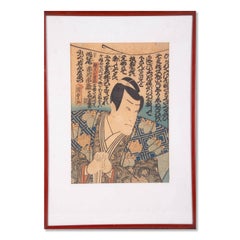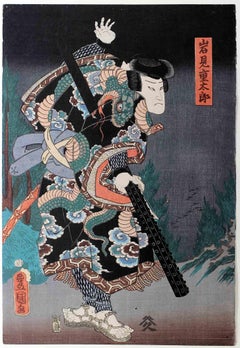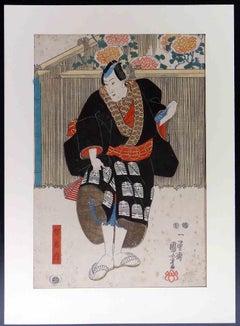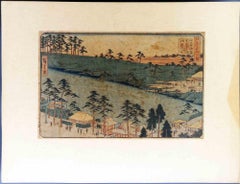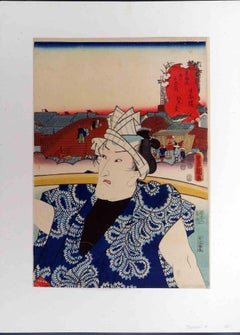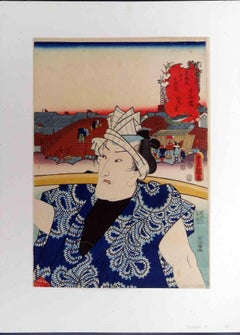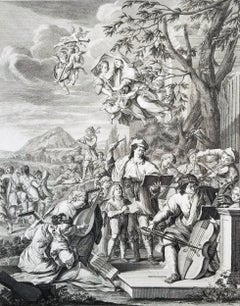Utagawa Kunisada III Figurative Prints
to
6
1
Overall Width
to
Overall Height
to
3
3
13
883
384
369
310
6
1
6
1
7
5
3
2
2
1
1
1
1
1
1
1
7
1
1
1
1
7
6
1
Artist: Utagawa Kunisada III
Utagawa Kunisada III (1848-1920) Ukiyo-E Woodblock Print "Portrait Of Samurai"
By Utagawa Kunisada III
Located in New York, NY
Title: Portrait Of Samurai
Medium: Woodblock Print
Style: Ukiyo-e
Size: 13 1/2"" x 9 1/2""
Frame Size: 18 1/2"" x 14 1/2""
Signature: Kunisada
Provenance: Collection from E...
Category
Early 20th Century Other Art Style Utagawa Kunisada III Figurative Prints
Materials
Washi Paper, Woodcut
Rônin in the Night, Armed with a Club - Woodcut by Utagawa Kunisada-19th Century
By Utagawa Kunisada III
Located in Roma, IT
This magnificent woodcut print signed Toyokuni III represents a Ronin in the night, armed with a club, and was realized by Utagawa Kunisada (1786-1865) in the mid 19th Century.
The ...
Category
19th Century Old Masters Utagawa Kunisada III Figurative Prints
Materials
Woodcut
Theater Actor in Black Coat on Stage- Woodcut by Utagawa Kunisada - 19th Century
By Utagawa Kunisada III
Located in Roma, IT
This figuration of a theater actor in a black coat on stage is the work of the Japanese artist Utagawa Kuniyoshi /1798-1861).
The brilliance of the colors, the graphic precision as ...
Category
19th Century Old Masters Utagawa Kunisada III Figurative Prints
Materials
Woodcut
Panorama d'un Paysage - Woodcut by Utagawa Kunisada - Mid-19th Century
By Utagawa Kunisada III
Located in Roma, IT
This beautiful woodcut print in the tradutional "oban" format is the work of the great Japanese master Utagawa Hiroshige (1797-1858).
It represents the landscape from a high point o...
Category
Mid-19th Century Modern Utagawa Kunisada III Figurative Prints
Materials
Woodcut
Man in Blue Coat Carrying Goods - Woodcut by Utagawa Kunisada - 19th Century
By Utagawa Kunisada III
Located in Roma, IT
This portrait of a man in Blue Coat carrying goods in the work of the japanese artist Utagawa Kunisada (1786-1865), otherwise known as Toyokuni III.
Whether through the use of color...
Category
19th Century Old Masters Utagawa Kunisada III Figurative Prints
Materials
Woodcut
The bearer in the Blue Coat - Woodcut by Utagawa Kunisada - Mid-19th Century
By Utagawa Kunisada III
Located in Roma, IT
The bearer in the Blue Coat is a superb original print, realized by the great japanese master of the Edo period, Utagawa Kunisada (1823-2880).
The quality of the support, the freshn...
Category
Mid-19th Century Modern Utagawa Kunisada III Figurative Prints
Materials
Woodcut
Man in Combat in front of the Reeds - Woodcut by Utagawa Kunisada - 19th Century
By Utagawa Kunisada III
Located in Roma, IT
This figuration of a man in combat in front of the reeds is the work of the japanese artist Utagawa Kunisada (1786-1865), otherwise known as Toyokuni III.
Whether through the use of...
Category
19th Century Modern Utagawa Kunisada III Figurative Prints
Materials
Woodcut
Related Items
Cypriano (A Basque Boy)
By Gerald Leslie Brockhurst
Located in Middletown, NY
Etching on cream wove paper. 6 5/16 x 3 3/4 inches (159 x 94 mm), full margin. Signed in pencil lower center margin, from the edition of 111. A well inked impression with a minor cre...
Category
Mid-20th Century American Modern Utagawa Kunisada III Figurative Prints
Materials
Handmade Paper, Etching
Vespera; Der Abend (Evening; The Evening) /// Johann Daniel Preissler Old Master
Located in Saint Augustine, FL
Artist: (after) Johann Daniel Preissler (German, 1666-1737)
Title: "Vespera; Der Abend (Evening; The Evening)"
Portfolio: Die Vier Tageszeiten (The Four Times of Day)
Year: 1723
Medium: Original Etching and Engraving on laid paper
Limited edition: Unknown
Printer: likely Johann Balthasar Probst, Augsburg, Germany
Publisher: Jeremias Wolff (Erben), Augsburg, Germany
Reference: Le Blanc No. 255, 38; Nagler No. 23
Sheet size: 22.5" x 16.63"
Image size: 17.38" x 13.63"
Condition: Soft handling creases and folds to sheet. Some scattered foxmarks in left margin. Two small tears skillfully repaired from verso in margins. Has been professionally stored away for decades. It is otherwise a strong impression in good condition with full margins
Extremely rare
Notes:
Provenance: private collection - Aspen, CO. Engraved by German artist Johann Balthasar Probst (1673-1750) after a drawing by German artist Johann Daniel Preissler (1666-1737). Comes from Preissler's 1723 "Die Vier Tageszeiten (The Four Times of Day)" portfolio of four etchings and engravings. Printed from one copper plate in one color: black. Descriptions of the portrayed image are printed in Latin and German.
Biography:
Johann Daniel Preissler, or Preisler (1666–1737) was a German painter and director of Nuremberg's Academy of Fine Arts. He was a notable member of a German artistic family, originating in Bohemia. His children included Johann Justin Preissler (1698–1771), Georg Martin Preisler (1700–1754), Barbara Helena Preisler (1707–1758; married to Oeding), Johan Martin Preisler (1715–1794), and Valentin Daniel Preisler (1717–1765), all in their time renowned artists. Most notable for his portraits, nudes and history paintings, Johann Daniel Preissler also produced drawings and frescoes. He was particularly known beyond his native Nuremberg for his "Die durch Theorie erfundene Practic", a sequence of works on art theory – the individual works were translated into several other languages and served as textbooks for students such as the Swiss Salomon Gessner...
Category
1720s Old Masters Utagawa Kunisada III Figurative Prints
Materials
Laid Paper, Engraving, Etching
$900
H 22.5 in W 16.63 in
Meridies; Der Mittag (Noon; The Midday) /// Johann Daniel Preissler Old Master
Located in Saint Augustine, FL
Artist: (after) Johann Daniel Preissler (German, 1666-1737)
Title: "Meridies; Der Mittag (Noon; The Midday)"
Portfolio: Die Vier Tageszeiten (The Four Times of Day)
Year: 1723
Medium: Original Etching and Engraving on laid paper
Limited edition: Unknown
Printer: likely Johann Balthasar Probst, Augsburg, Germany
Publisher: Jeremias Wolff (Erben), Augsburg, Germany
Reference: Le Blanc No. 255, 38; Nagler No. 23
Sheet size: 22.5" x 16.32"
Image size: 18.13" x 14.32"
Condition: Soft handling creases and folds to sheet. A few light areas of staining and scattered small areas of discoloration in margins. Two small tears skillfully repaired from verso in margins. Has been professionally stored away for decades. It is otherwise a strong impression in good condition with full margins
Extremely rare
Notes:
Provenance: private collection - Aspen, CO. Engraved by German artist Johann Balthasar Probst (1673-1750) after a drawing by German artist Johann Daniel Preissler (1666-1737). Comes from Preissler's 1723 "Die Vier Tageszeiten (The Four Times of Day)" portfolio of four etchings and engravings. Printed from one copper plate in one color: black. Descriptions of the portrayed image are printed in Latin and German.
Biography:
Johann Daniel Preissler, or Preisler (1666–1737) was a German painter and director of Nuremberg's Academy of Fine Arts. He was a notable member of a German artistic family, originating in Bohemia. His children included Johann Justin Preissler (1698–1771), Georg Martin Preisler (1700–1754), Barbara Helena Preisler (1707–1758; married to Oeding), Johan Martin Preisler (1715–1794), and Valentin Daniel Preisler (1717–1765), all in their time renowned artists. Most notable for his portraits, nudes and history paintings, Johann Daniel Preissler also produced drawings and frescoes. He was particularly known beyond his native Nuremberg for his "Die durch Theorie erfundene Practic", a sequence of works on art theory – the individual works were translated into several other languages and served as textbooks for students such as the Swiss Salomon Gessner...
Category
1720s Old Masters Utagawa Kunisada III Figurative Prints
Materials
Laid Paper, Engraving, Etching
$900
H 22.5 in W 16.32 in
The Crucifixion (Christ on the Cross) /// Jesus after Albrecht Dürer Old Masters
Located in Saint Augustine, FL
Artist: Lambrecht Hopfer (German, Active c. 1525-1550)
Title: "The Crucifixion (Christ on the Cross)"
Portfolio: (after) The Engraved Passion
*Issued unsigned, though monogram signed by Hopfer in the plate (printed signature) lower right
Circa: 1530 (second state of three, published c. 1690)
Medium: Original Etching on laid paper
Limited edition: Unknown
Printer: The Hopfer family, Augsburg, Germany; (David Funck, Nuremberg, Germany)
Publisher: The Hopfer family, Augsburg, Germany; (David Funck, Nuremberg, Germany)
Reference: Bartsch No. VIII.527.12; Hollstein No. 12.II
Framing: Recently framed, the sheet is floated over, and top-matted with a 100% cotton fabric rag mat from Holland in a wood moulding and Museum glass
Framed size: 14.88" x 13.88"
Sheet size: 5.5" x 3.63"
Condition: Trimmed to platemark. A few tiny professional repairs: at elbow of Jesus's right arm and the inside thigh of Jesus. Some light skinning upper right corner and lower right area. It is otherwise a strong impression in good condition
Very rare
Notes:
Provenance: private collection - Green Bay, WI; acquired from Sotheby's, New York, NY in c. 2015. The artist Lambrecht Hopfer's printed monogram signature "LH" lower right. The printer/publisher David Funck's (plate) number "182" lower right. This etching is after Albrecht Dürer’s 1511 engraving "The Crucifixion (Christ on the Cross)", ("Dürer-Katalog" - Meder No. 13, page 73). Printed in black from an iron plate. The image depicts Christ on the cross at center, the Virgin at left, two Maries behind her, St. John standing at right, a Roman solider behind him. It is after the eleventh plate of Dürer's sixteen plates from his 1507-1513 "The Engraved Passion" series, ("Dürer-Katalog" - Meder No. 3-18, page 70-74).
"The print was originally designed without the number engraved in the lower margin (First state: Lambrecht Hopfer, c. 1530). The Hopfers' descendant David Funck (Nuremberg, 1642–1705) acquired over two hundred of their original iron plates, engraved numbers into them, and re-printed them around 1686-1700. The "182" indicates that "The Crucifixion" was the 182nd print in Funck’s series (Second state: David Funck, c. 1686-1700). About a century later, 92 of these plates were acquired by Carl Wilhelm Silberberg in Frankfurt and printed for the third and final time in the book "Opera Hopferiana", of which "The Crucifixion" was the 90th print (Third state: Carl Wilhelm Silberberg for "Opera Hopferiana", 1802)". - Elizabeth Upper, Cambridge University Library, University of Cambridge, Cambridge, UK
Biography:
Lambrecht (Lambert) Hopfer (Active c. 1525-1550) was a German Old Masters printmaker. He was the brother of Hieronymus Hopfer (Active c. 1520-1530) and son of Daniel Hopfer...
Category
16th Century Old Masters Utagawa Kunisada III Figurative Prints
Materials
Etching, Laid Paper
Aurora sive Tempus Matutinum; Der Wohl und Übel angewandte Morgen /// Old Master
Located in Saint Augustine, FL
Artist: (after) Johann Daniel Preissler (German, 1666-1737)
Title: "Aurora sive Tempus Matutinum; Der Wohl und Übel angewandte Morgen (Dawn or Morning Time; The Morning Used for Better or For Worse)"
Portfolio: Die Vier Tageszeiten (The Four Times of Day)
Year: 1723
Medium: Original Etching and Engraving on laid paper
Limited edition: Unknown
Printer: likely Johann Balthasar Probst, Augsburg, Germany
Publisher: Jeremias Wolff (Erben), Augsburg, Germany
Reference: Le Blanc No. 255, 38; Nagler No. 23
Sheet size: 22.57" x 16.38"
Image size: 17.75" x 14"
Condition: Soft handling creases, folds, and scattered faint areas of discoloration to sheet. Three tears skillfully repaired from verso. Has been professionally stored away for decades. It is otherwise a strong impression in good condition with full margins
Extremely rare
Notes:
Provenance: private collection - Aspen, CO. Engraved by German artist Johann Balthasar Probst (1673-1750) after a drawing by German artist Johann Daniel Preissler (1666-1737). Comes from Preissler's 1723 "Die Vier Tageszeiten (The Four Times of Day)" portfolio of four etchings and engravings. Printed from one copper plate in one color: black. Descriptions of the portrayed image are printed in Latin and German.
Biography:
Johann Daniel Preissler, or Preisler (1666–1737) was a German painter and director of Nuremberg's Academy of Fine Arts. He was a notable member of a German artistic family, originating in Bohemia. His children included Johann Justin Preissler (1698–1771), Georg Martin Preisler (1700–1754), Barbara Helena Preisler (1707–1758; married to Oeding), Johan Martin Preisler (1715–1794), and Valentin Daniel Preisler (1717–1765), all in their time renowned artists. Most notable for his portraits, nudes and history paintings, Johann Daniel Preissler also produced drawings and frescoes. He was particularly known beyond his native Nuremberg for his "Die durch Theorie erfundene Practic", a sequence of works on art theory – the individual works were translated into several other languages and served as textbooks for students such as the Swiss Salomon Gessner...
Category
1720s Old Masters Utagawa Kunisada III Figurative Prints
Materials
Laid Paper, Engraving, Etching
$900
H 22.57 in W 16.38 in
Apollo, plate 11 from the series of The Gods in Niches
Located in Middletown, NY
by Jacopo Caraglio (after Rosso Fiorentino)
Rome: Carlo Losi, 1526. Engraving on cream laid paper, 8 1/2 x 4 3/8 inches, 215 x 110 mm), thread margins. In very good condition with a...
Category
17th Century Old Masters Utagawa Kunisada III Figurative Prints
Materials
Laid Paper, Handmade Paper, Engraving
Schwarze Madonna
Located in Wien, 9
Auguste Kronheim was born in Amsterdam in 1937. The artist makes woodcuts and drawings. She received her training in drawing from Hanns Kobinger and graduated from the Linz Federal T...
Category
20th Century Modern Utagawa Kunisada III Figurative Prints
Materials
Woodcut
Elwood W. Bartlett, Wisconsin Farm, about 1945, mid-century wood engraving
Located in New York, NY
Elwood Warren Bartlett is a Wisconsin native who also worked in Indiana.
Largely self taught as a printmaker, Bartlett worked in a style that once identified as his, immediately t...
Category
1940s American Modern Utagawa Kunisada III Figurative Prints
Materials
Woodcut
Tolosa (Toulouse); Leaf LXXI from Hartmann Schedel's Nuremberg Chronicle
Located in Middletown, NY
Woodcut on laid paper, 8 3/8 x 9 1/8 inches (212 x 233 mm), the full sheet. In excellent condition with text and portraits of Empedocles, Sapho, Zeuxis and others on the verso, as is...
Category
15th Century and Earlier Old Masters Utagawa Kunisada III Figurative Prints
Materials
Ink, Handmade Paper, Laid Paper, Woodcut
Rancho Woodcut Heart, 1982
By Jim Dine
Located in Palo Alto, CA
One of Jim Dine’s most iconic motifs, the romantic Rancho Woodcut Heart work illustrates the story of hope and love through a symbolic image of a large red heart. With the contrast o...
Category
1980s Modern Utagawa Kunisada III Figurative Prints
Materials
Woodcut
Limon Lavrae: A 17th C. Hand-colored Engraving of Lemon Anatomy by G. Ferrari
By Giovanni Battista Ferrari
Located in Alamo, CA
This 17th century hand-colored engraving of a lemon entitled "Limon Lavrae", plate 219 from Giovanni Baptista Ferrari's publication "Hesperides, sive, De Malorum Aureorum Cultura Etu...
Category
17th Century Old Masters Utagawa Kunisada III Figurative Prints
Materials
Engraving
$1,575
H 23.25 in W 18.5 in D 0.75 in
The Triumph of Caesar: Plate IV of IX
By Andrea Mantegna
Located in Middletown, NY
Andreani, Andrea, after Andrea Mantegna
The Triumph of Caesar: Plate IV of IX
1599. Chiaroscuro woodcut in colors printed from four blocks on laid paper in dark brown, grey, and thr...
Category
16th Century Old Masters Utagawa Kunisada III Figurative Prints
Materials
Handmade Paper, Laid Paper, Ink, Woodcut
Utagawa Kunisada Iii figurative prints for sale on 1stDibs.
Find a wide variety of authentic Utagawa Kunisada III figurative prints available for sale on 1stDibs. You can also browse by medium to find art by Utagawa Kunisada III in woodcut print and more. Much of the original work by this artist or collective was created during the 19th century and is mostly associated with the Old Masters style. Not every interior allows for large Utagawa Kunisada III figurative prints, so small editions measuring 10 inches across are available. Customers who are interested in this artist might also find the work of Francesco Cecchini, William Hogarth, and Giovan Battista Falda. Utagawa Kunisada III figurative prints prices can differ depending upon medium, time period and other attributes. On 1stDibs, the price for these items starts at $284 and tops out at $891, while the average work can sell for $535.
